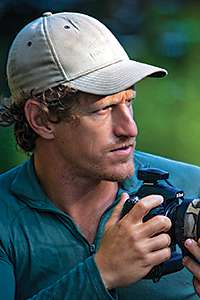Photo: Carlton Ward Jr.
SHARE:

Carlton Ward Jr.
Florida Icon
Florida Icon: Carlton Ward Jr.
Photojournalist, Tampa; age 40
Florida is not like Colorado, where you can look and see the Rocky Mountains and know that the snowmelt is a source of your water and those high, beautiful places are where wildlife can still roam. We have an amazing, wild interior that is the source of almost all of our drinking water. It’s the source of our $100-billion agriculture economy. It’s where all of our wildlife in any significant scale can still survive, but it’s hiding in plain sight. We have to treat our vast wild spaces as our sacred mountains and the source of our life and economy.
I grew up in Pinellas County and was fortunate to spend a lot of time on the water. My family also has some ranch land in Hardee County, near Limestone, and something I often say is I kind of had one foot in the suburbs and one foot in the woods growing up, which I think had a lot to do with my perspective on conservation.
There’s no doubt that Florida is an eclectic and weird place, but I think that even gets amplified further in the media. And that is a challenge. If we want to foster a true sense of place and identity, rooted in the real Florida, we’re having to overcome a lot of stereotypes.
The way I look at it, it’s not necessarily an argument against more houses and roads in Florida. It’s an argument for where to put those new houses and roads.
My mom always encouraged a sense of wonder in me about things, like picking up seashells and learning the difference between univalves and bivalves.
I feel like there’s a tendency to portray the world of ‘A Land Remembered’ as if it’s in the distant past, but, in fact, that world still exists in Florida today. You get out on a cattle ranch with a fifth-, sixth-, seventh-, eighth-generation cattle rancher whose family has been working and managing that same land for, in some cases, two centuries and you’ll see that the Florida frontier still exists but needs our appreciation to continue to exist.
There’s this myth that the Florida Forever program is just a government land grab and its just there to buy more public land, to take it off the tax rolls and to strap the public with the long-term management burden. Well, the Florida Forever program also invests significantly in conservation easements, and I think that is a real common ground that even the most conservative lawmakers can see value in. It’s not a matter of the state having to pay the full price of the land and then manage it forever. It’s actually a way to buy the development rights so the landowner can afford to keep owning the land and continue operating it for agriculture.
It’s a challenge to find the discipline to stay working within your purpose.
I have such awe and respect for the people who, every morning before dawn, saddle up their horses and coil up their lariats and whips, and ride out to work the herds. They are almost like knights out there because of their commitment and connection to the land. They ensure that those lands still serve as habitats for wildlife and remain the watersheds that we all benefit from downstream. Those cowboys and ranchers are heroes to me for whatthey’re doing for our state.
One of my big concerns has to do with changes in the media landscape. As circulations of newspapers and magazines shrink along with budgets, I worry about the future of indepth journalism that is so important for our democracy.
I’m an eighth-generation Floridian. My great-grandfather was Doyle E. Carlton, the governor of Florida from 1929 to 1933. He was also one of the founders of the Carlton Fields law firm in Tampa.
The people who are the most vocal opponents to land conservation will give you statistics about what percentage of Florida is already in public ownership and, therefore, why do we need any more? I want to show them a map that shows them why. We need more because this amazing national forest that we protected decades ago and this beautiful state park are not connected to one another, and if we can just help this rancher through a conservation easement or help expand this wildlife refuge so everything fits together, well, that’s just a clear, common sense, pragmatic approach.
There’s something always nostalgic and adventurous about being in Everglades City and going by the Rod and Gun Club just to see the old wooden bar where all these past presidents have been during fishing trips.
I’m encouraged by something the Department of Agriculture has started under Adam Putnam — which is bringing school lunches under the purview of the Department of Agriculture rather than the Department of Education, which gives schools a chance to source produce locally. That’s really cool. It’s healthy. It helps educate kids about the source of their food. And it also gives farmers one more reason not to sell out to a housing development.
Apalachicola Bay is a magical place.
The Florida Wildlife Corridor project is a life’s work. I hope to spend the foreseeable future of my career on this, telling these stories of the corridor. I want to be able to, in 30 years, take my daughter to revisit some of the places we’ve visited on our expeditions and have those places still be there.
In case you missed it:
























